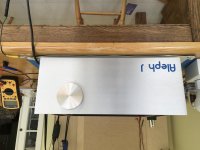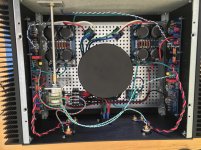PS PCB & 2 UMS 40x300mm heatsinks ordered along with the pieces to finish the Aleph J & PS. I'll get on this after vacation.
I'm purchasing the AS-4220 - 400VA 20V TRANSFORMER and plan on using the Diodes and heatsinks instead of the bridge. For caps I was planning on 88,000 uF per rail. For the diodes, are the 30A 200V still okay ?
These are what I was looking at-
FFA60UP20DNTU ON Semiconductor / Fairchild | Mouser
Thanks,
David
These are what I was looking at-
FFA60UP20DNTU ON Semiconductor / Fairchild | Mouser
Thanks,
David
18V secondaries are specified, why the AS4220?
Honesty, buy the 20V.
Some of the recommendations on the forum. I just want to make sure that I change what needs to be changed for this transformer on the PCB board.
Didn’t know that...I’m new to this thread. You would want to have caps rated at at least 35V as you’ll be making ~28 V after the rectifiers.
Didn’t know that...I’m new to this thread. You would want to have caps rated at at least 35V as you’ll be making ~28 V after the rectifiers.
Thanks. I'm new here too and although I can build with clear instructions, I am still lost when it comes to understanding the electrical principles.🙁
The 20v transformer will make no real differences aside from maybe a bit more power. No changes need to be made to the circuit aside from using 35v caps in the PSU, which is just a good idea in general.
The diode you picked out is in the TO-3P package, and might not fit a standard heatsink. TO-247 is just a tad smaller and will fit most PS mount sinks like the ones needed for the discrete bridges.
BYV72EW-200,127 WeEn Semiconductors | Mouser
The diode you picked out is in the TO-3P package, and might not fit a standard heatsink. TO-247 is just a tad smaller and will fit most PS mount sinks like the ones needed for the discrete bridges.
BYV72EW-200,127 WeEn Semiconductors | Mouser
I have a rookie question.
Finally going to start building this amp in the next week or so (hopefully family doesn’t bug me) and I plan on using an inductor (one for each rail) instead of resistors on the store power supply board. Would I simple wire the inductor in one of the open spots for the resistor or would it go somewhere else?
Finally going to start building this amp in the next week or so (hopefully family doesn’t bug me) and I plan on using an inductor (one for each rail) instead of resistors on the store power supply board. Would I simple wire the inductor in one of the open spots for the resistor or would it go somewhere else?
Just finished my first Aleph J build! It isn’t up and running as it’s blowing the .5Amp 250v fuse I had on hand. It did pass the light bulb tester.
Looking at the FirstWatt Aleph J manual it states a 4Amp 250v slow blow so I’m guessing that is what is needed. Is this correct? Anyway had to post a picture, just cause.
Edit: Sorry about the upside down picture, I’m a goof.
Looking at the FirstWatt Aleph J manual it states a 4Amp 250v slow blow so I’m guessing that is what is needed. Is this correct? Anyway had to post a picture, just cause.
Edit: Sorry about the upside down picture, I’m a goof.
Attachments
Thanks Jim. Once the 4 Amp fuses are installed I’ll get started on setting offset and bias. I’ll keep my fingers crossed that it goes well. 😉
Pass DIY Addict
Joined 2000
Paid Member
Nice work, Scott! Looks like you have some thermistors under your volume pot, so this should help with power inrush at turn on, but you do need a bigger fuse. A 4A fuse should do it, though you might get away with a 3A...
Whose transformer with a cover did you use? Is that from Antek?
Whose transformer with a cover did you use? Is that from Antek?
Last edited:
Hi Eric, thanks. I’ve ordered some 4 Amp fuses and should have them Monday thanks to Amazon. I used .5 Amp fuses I had purchased for the Pearl 2 built last year without giving consideration to the fact they may not be the correct size. Pretty foolish on my part. Live and learn, the devil is in the details, absativly! Both the transformer (model 3218) and cover are from Antek. They make nice products.
Thanks mkane77g!
Thanks mkane77g!
Last edited:
Hi!
I'm just collecting parts to my build and just bought 8 matched IRFP240.
The seller suggested to
Distortion In Power Amplifiers - Home Warranty Appliances
I'm little lost here😕
What do you think about this idea?🙂
I'm just collecting parts to my build and just bought 8 matched IRFP240.
The seller suggested to
decrease the value of the source resistors from 0.47 Ohms to 0.18 - 0.24 Ohms.
Very good "matched transistors allow this" he said
The reason to do so was:
Low output impedance, low output noise. Also lower value reduce crossover distortion in Class A/B. Very good "matched transistors allow this" he said
The reason to do so was:
Distortion In Power Amplifiers - Home Warranty Appliances
I'm little lost here😕
What do you think about this idea?🙂
.
This will increase the current and that will reduce distortion at the cost of greater heatsink requirements. Personally I believe that Nelson has very good ears and has chosen the voltage and current to give the amount (low) and the mix of distortion orders that sounds good (falling at higher orders). I would not change the values unless my speakers were the demanding type that needed it and then I would be more likely to get different speakers.
All that said this is DIY and Nelson would be happy for you to experiment and learn so I would suggest first trying Nelson's version and then modifying it to see how your changes affect the sound. If you plan on doing this, you will need to start with the larger heatsinks like the ones on the 5U from the DIYaudio store.
Jim
All that said this is DIY and Nelson would be happy for you to experiment and learn so I would suggest first trying Nelson's version and then modifying it to see how your changes affect the sound. If you plan on doing this, you will need to start with the larger heatsinks like the ones on the 5U from the DIYaudio store.
Jim
Last edited:
This will increase the current and that will reduce distortion at the cost of greater heatsink requirements. Personally I believe that Nelson has very good ears and has chosen the voltage and current to give the amount (low) and the mix of distortion orders that sounds good (falling at higher orders). I would not change the values unless my speakers were the demanding type that needed it and then I would be more likely to get different speakers.
All that said this is DIY and Nelson would be happy for you to experiment and learn so I would suggest first trying Nelson's version and then modifying it to see how your changes affect the sound. If you plan on doing this, you will need to start with the larger heatsinks like the ones on the 5U from the DIYaudio store.
Jim
Oh. Thanks for clarifying that. 🙂
I'm going to use the 5U heatsink (already got this from another build), and start with Nelson's version .
Br Tommy
Last edited:
- Home
- Amplifiers
- Pass Labs
- Aleph J illustrated build guide

